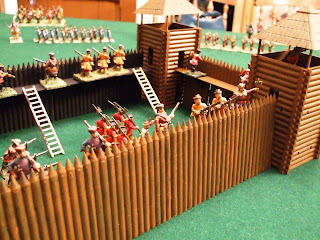No midweek game last week as we had a full weekend of gaming organised. On Saturday it was an Indian Mutiny game in 15mm using the 'Devi's Wind' rules. The scenario was based on the arrival of the seige train which would enable the East India Company's troops to breach the walls of Dehli. The mutineers needed to prevent it's arrival and so launched repeated attacks against the head and flank of the approaching column. On the opposite flank attacks were made on Hindu Rao's house which was garrisoned by Ghurkas. In the centre the Prince of Dehli, the mutineer commander used his abundant artillery to batter the defences opposite him prior to launching his own attack. Here are a few photos; firstly the beseigers' position from behind their right flank,with Hindu rao's House in the far distance
The East India Companies front line, this was destroyed by the heavy fire from the mutineer artillery
Troops from the Naval Brigade move into the marshy area on the beseigers' right to support their artillery and protect the flank of the seige train
What the battle was all about, the head of the seige train makes it's stately progress towards the seige lines.
The mutineer left fought bravely, sending wave after wave of attacks on the relief column. They did have some success; the gun crews shown in the photo with the Naval Brigade had to be replenished twice due to fire from the mutineers. Also the native cavalry defeated a unit of Lancers and set off in pursuit, only to met with concentrated rifle fire from the seige lines and then overwhelmed by Company reinforcements. The battle revolved around control of the village covering the bridge which was the only route for the seige train. The relief train commander commtted his elite unit (Highland infantry) to the defence and although they suffered heavy casualties they managed to hold on.
The mutineers on the opposite flank fared little better. Three separate attacks on Hindu Rao's House melted away before the fire of the defenders and a flanking attack by the cavalry was severely hampered by the close terrain.
Two photos of the Mutineer defences
The Company cavalry holding off the Mutineers
The Prince supports his troops
Mutineer cavalry trying to work round the beseigers' flank
The battle for the vital village
The mutineers' attack in the centre was rather slow in forming up (stories later circulated that the Prince was not aware there were two gates he could use to move troops out of the city, "I have a man to look after such things" he is reported to have said.) Anyway, by the time everything was ready,the flank attacks were petering out and when a loud cheer was heard from the seige lines signifying that the supply column had begun to arrive the Prince ordered that all forces return to the city.
This was an enjoyable game and although the rules have some shortcomings when you fight a large action with plenty of troops the minor details are not as significant.
It was an early start on the Sunday morning as the detatchment of Gentlemen Pensioners, having obtained their visas, set off over the Pennines to Yorkshire. The Vapnartak show has become increasingly popular over the last few years and this trend continued. We were helping out on the Lance and Longbow stand at the show and putting on Grandson as a demonstration game. Little progress was made in the morning as most of the time we were talking to visitors about the game, which of course is what we were there for in the end.
The Seige of Newcastle
Indian Mutiny
Star Wars
Pegasus Bridge
Grandson
There were several large games on show,among which were the Wargames Holiday Centre with a demo game of the Indian Mutiny in 25mm and York Wargames Club with the Seige of Newcastle. They also provided two participation games Attack on the Death Star and Pegasus Bridge. The Ilkley Lads had an 'Old School' game using the Maurice rules, a welcome alternative to games with scenery which 'overpowers' the game.
As usual there was a strong trade presence and although I restricted myself to one pot of paint and a 25mm bridge there were plenty of customers stocking up for the coming year.
Our game was adjudged a Burgundian victory although two of the Swiss pike blocks had smashed through the Burgundian infantry. The Burgundian gendarmes were still a potent force and threatened the flanks of the Swiss units.
As usual a very enjoyable 'Pensioners' weekend, thanks are due to Steve and Gwen for their hospitality, Roy (Indian Mutiny) and Bob (Grandson) for organising the games. Here's to the Pensioners AGM in June!


























